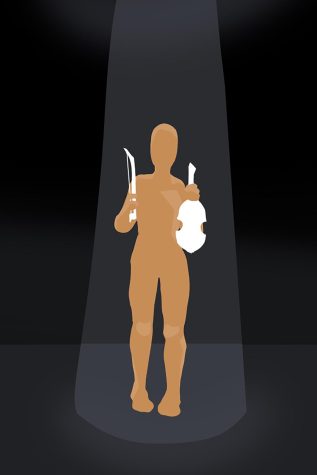Your donation will support the student journalists of Iowa City High School. For 2023, we are trying to update our video and photo studio, purchase new cameras and attend journalism conferences.
A Push For Diversity In Music
A lack of diversity within the City High Music Department makes students and staff question what can be done to increase representation
February 8, 2022
Defined by Merriam-Webster, diversity is “the state of having people who are different races or who have different cultures in a group or organization”.
In 2014, the Iowa City Community School District’s Equity Department began developing the ICCSD’s Comprehensive Diversity, Equity, and Inclusion Plan. The goals of this comprehensive equity plan were to identify inequities that occur within the school district and provide methods and strategies to address them along with creating equitable and inclusive environments. The ICCSD has been working towards achieving the six goals set in 2014, yet still, diversity is not represented in many aspects.
“Diversity in music is important. It helps create a community [among] people who may not already be in the same groups; not only race wise, but also within a race. For example upperclassmen and underclassmen, popular kids and not popular kids, and different ethnicities. It’s a thing that helps to bond people together,” Maddie Schuh ‘22 said. Schuh participates in 4th Avenue Jazz Co., Wind Ensemble, Concert Choir, and Full Orchestra.

Though City High is the tenth-ranked high school based on ethnic, economic, and cultural diversity in the state of Iowa, that reality is not well reflected in the district’s music department.
“You go to City High and you see so much diversity everywhere. Everywhere you turn there’s [diversity, especially] racial and sexual orientation diversity. Then you get to band and it’s totally not an accurate representation at all,” Drum Major and saxophonist in Symphony Band, Combo, and Jazz Collective, Iya Alexander ‘22 said.
Naomi Hemley ‘25 who participates in Treble Choir, Select Treble Ensemble, and Charisma show choir also sees the lack of diversity reflected when participating in choir.
“I noticed at show choir competitions that when I looked at the other show choirs there’s always only one, maybe max four People of Color; even if it’s a bigger choir. I’ll be like, ‘oh wow, that is a white choir’. But then I’ll look back at our choir, and our choir is super white too,” Hemely said.
Similar feelings are shared by students and staff members alike. Tyler Hagy, director of Treble Choir, Select Treble Ensemble, Concert Choir, and Fourth Avenue Jazz Co. show choir agrees that the diversity within the music department is not representative of the rest of City High as a whole.
“I would not say that we are exactly representative of the population that we have at the school. Generally, people from certain races or ethnic backgrounds are less represented in terms of music in general, but also in the professional music career. I would say that we are similar to what is seen in professional music right now,” Hagy said.
According to date from ICCSD, in 2019, 61% of students enrolled in a junior high music program were white, 21% were Black, 10.5% were Hispanic, 5.8% were Asain, 37.6% were enrolled in Free and Reduced Lunch (FRL), 10.6% have an Individualized Education Program (IEP), and 8.8% are English Language Learners (ELL). When compared to the ICCSD’s high school music program statistics, it’s clear that the district is not retaining their students of color, FRL or IEP students in the music department.
“[Being one of the only African American people in band] did feel a little weird because I was surrounded by people who weren’t like me. I’ve learned to just not look at that, because we are all in band. It doesn’t really matter.” Alexander said. “There was a time where I was like, this doesn’t feel right because at the concerts you just see me and then everybody else and it did feel weird.”
The lack of diversity in the classical music field is not something that is unique to City High. Classical musicians in particular, are largely white; a disparity that extends to the professional level. According to data compiled by the League of American Orchestras, despite making up 32% of the American population, Black and LatinX musicians comprise only 4% of American orchestras.
“There is a large lack of diversity that I’ve seen in music programs at City. In all of the music that I am in, it is predominantly white students with only a few students who are of a different ethnicity. Whenever there is something that brings diversity (or lack thereof) to attention, it always surprises me, just how little representation there is in the Arts at City,” Schuh said.
City High orchestra director Megan Stucky-Swanson believes there is an established issue of classical music being reserved for mostly white, upper-class individuals. Stucky-Swanson says that in classical music, the inequity extends to not just the musicians, but also the audience.
“The [classical music] audience is incredibly white and old. Not to sugarcoat it, but it’s sad. Basically everything is written by a white man,” Stucky-Swanson said.
In the United States, historically, there has been a gravitational pull of the classical genre towards white people.
“If you look at a modern-day, professional symphony orchestra, a majority of players in that ensemble will be white, there will be several Asian people from various Asian backgrounds, but beyond that, there are generally not many others,” Hagy said.
Because music is often started at a young age, gaining access to musical instruments and music lessons is frequently the first challenge that students face. Some students of a lower socioeconomic status don’t necessarily have parents who can afford the extra costs that come with practicing music.
“There are lots of different kinds of barriers and some people might [face] all of them, and some people might only [face] some of them, and probably no two people [face] exactly the same ones,” Hagy said.
Those who are able to afford music lessons, often private, are more likely to pursue music as they grow older. Another barrier to participation in classical music is access to the music and concerts themselves.
“Classical music has often been thought of as something that wealthy people do in this country, that generally people of a lower socioeconomic status do not partake in. The average price of a ticket to the symphony is probably over $100; for a single ticket, for one event. And if you think about taking a family to that or just hiring a babysitter and everything, that’s a huge economic investment just for access to see it live,” Hagy explained.

City High music teachers believe the push for diversity not only benefits the students, but also the music.
Becoming More Inclusive
There are several reasons for the lack of racial diversity in the professional classical music career, but the issue is systemic; and due to decades of institutional racial bias.
The UK-based Donne Foundation, an organization that works to address inequalities in the music industry, whose mission statement claims that to achieve equality and diversity, “it is important that we move beyond tokenism for political correctness and aim for comprehensive and genuine inclusivity to permeate through the layers”.
“As a young musician or young anything for that matter, if you can see yourself or people that look like you doing something, it feels different than if it’s people that don’t look like you and may not understand you or your experiences. It can help you be inspired to continue to try and pursue that goal,” Hagy said. “There are several barriers to participation [in music], but I think that’s one that limits students’ desire even.”
Aaron Ottmar directs the Symphony Band along with the Jazz Ensemble, Jazz Collective, and Jazz Lab at City High. He emphasizes the importance of representation at all levels, not just when it comes to music.
“You [students] are looking up to people who are in the field or in the career that you want to be in. Even if it’s just an interest, that interest can be furthered by seeing people who have a similar background to you and are really excelling and thriving,” Ottmar said.
Stucky-Swanson sees increasing diversity in the music field as not only beneficial for students, but also essential for all musicians.
“I think we can learn from so many of the other cultures that are in the classes with us,” Stucky-Swanson said. “It gives us different perspectives, access to different kinds of music and makes us more well-rounded as musicians; having the ability to observe, practice and learn about different cultures of music.”
The music staff at City High is eager to increase the diversity within their ensembles, however one of the problems that they run into is that a big part of the music education process begins at a young age. Ottmar thinks that the most successful solutions to this issue have to be implemented when students are beginning band and orchestra in elementary school.
“We can do things here, but the bigger impact will probably be at the younger levels. Getting those kids interested there and having them stick with it going up to the high school level,” Ottmar said.
Stucky-Swanson echoes the importance of figuring out and solving the barriers which cause kids to quit music after elementary school.
“The band and orchestra at the elementary level; it’s well represented. We have to figure out the adversity there and what is preventing all of those children from moving forward, because there’s a huge drop in that population between elementary school and junior high,” Stucky-Swanson explained.
Over the past year, the ICCSD’s Performance Music department has begun making changes in the music programs at both the elementary and junior high levels. The goal of these changes has been to increase access to music lessons and musical instruments for students who have previously faced barriers to participation.
Eastside elementary bands in ICCSD recently changed their ensemble rehearsals to take place before school and at the elementary school itself. The goal of these changes was to retain more students by making time and transportation less of a problem. Previously, students in elementary band and orchestra would have to provide their own transportation to either City High or South East Junior High to rehearse after school. Stucky-Swanson likes this solution that the band program has implemented, but says that it can not be done sustainably by the orchestra program because their staff is already stretched thin.
“The orchestra staff on the east side doesn’t have more than three people, so there’s no way that we can do that. [Students] still have to get over to South East Junior High every Tuesday at 4:30 and then [get] picked up at 5:20. For a lot of students that’s really difficult to make work,” Stucky-Swanson said.
Another change to music education took place at South East Junior High this year in the form of a new class. According to Stucky-Swanson, this class offers a way for students to join band or orchestra who haven’t participated in elementary school. This addition helps to address the learning curve issue that students face who may want to join a music ensemble later than their peers.
“There’s a beginning option this year. It was only one trimester because they needed to see the interest, but they did have some beginners that joined this year,” Stucky-Swanson said.
City High has begun offering two new exploratory music classes which are aimed at giving more students a chance to explore joining music groups once they reach high school. Hear My Voice and Exploratory Music are both trimester classes that are less traditional music class experience than band, orchestra, or choir. They both give students an opportunity to learn about and explore styles of music that are of interest to them.
Although transportation continues to be one of the biggests barriers students face, the ICCSD has been trying to lessen the financial barriers that students face in order to participate in music.
“One thing the district has done a really nice job with, especially this year and last year, is getting instruments into the hands of those students that can’t afford to rent or purchase. I am proud of our district for that,” Stucky-Swanson said.
All of the music directors at City High believe that programming repertoire from a wide range of composers is one of the most impactful things that they can do at the high school level.
“I think it comes down to diversity of literature from early age, through high school, through college,” Hagy said. “Not necessarily just in terms of the ethnic background of the composer, though that is important, but also the stylistic nature of the music itself, but not tokenizing it either. I think it’s important to diversify the repertoire that you’re doing.”
Ottmar echoes the belief that music selection is one of the most impactful things that directors can do to increase diversity in their music classes.
“I think it’s upon us as teachers that we have to really do some digging because there are a lot of composers out there,” Ottmar said. “But at this point, unfortunately, they’re not receiving the recognition or the attention that they deserve.”
Because the diversification of music programs across the country has been an ongoing issue for so many years, change won’t come overnight.
“How do we inspire students to want to be a part of this? Not just here, because we certainly can do more in this building, but also with younger-age students. How can we connect with them?” Hagy questioned. “It’s not going to change tomorrow. It’s not going to change even in a year from now, but we can put the mechanisms in place so three years down the road, ten years down the road, there is a drastic change in the culture of this place, so it feels more inclusive and more representative of the entire student body.”
Stucky-Swanson feels optimistic about the future of increased diversity within the City High music department.
“I think directors are starting to do a better job of trying to learn the right way; attending conferences, learning about the appropriate way to diversify a music program, and slowly incorporating different cultures of music by bringing in people that know about those cultures of music and not pretending to know themselves,” Stucky-Swanson said. “I think that we’re slowly moving in the right direction. Definitely not there yet, but we’re getting closer. And we’re trying.”

